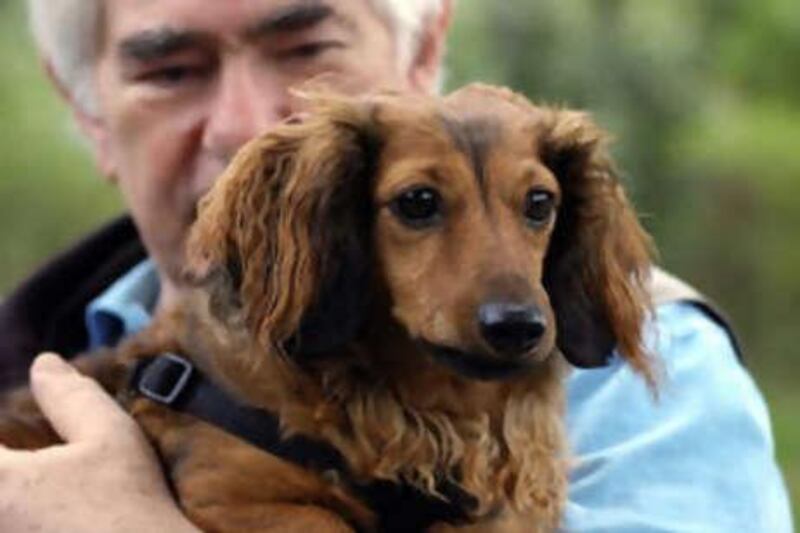BERLIN // The dachshund, disrespectfully called sausage dog in the Anglo-Saxon world, is as dear to German hearts as Lederhosen, oompah bands and beer, which explains why recent figures showing a steep drop in births of the frisky, centuries-old breed have sparked concern that it may be dying out. The German Dog Federation said births of dachshunds registered by breeders in Germany have slumped 35 per cent over the past decade to 7,120 in 2007. It is a far cry from the 1970s when 28,000 puppies were born a year and the short-legged dogs were a ubiquitous sight snoozing under cafe tables or impatiently tugging their owners along behind them.
Although dachshunds remain the second most popular dog breed in Germany after German shepherds (Alsatians), the figures were deemed alarming enough to provoke anxious headlines about the threat to a cherished national symbol of Teutonic stubbornness. "The German Dachshund Must Not Die!" wrote Die Welt newspaper. Pet owners are increasingly opting for more fashionable dogs such as golden retrievers, Labradors, Jack Russells and Highland terriers, the dog federation said. Even pugs are gnawing at the dachshund's market share with an almost four-fold increase in births in the past 10 years.
"If you're looking for a dog these days there's simply a far greater range of breeds on offer than 20 years ago, and the traditional German dogs are suffering from that," said Udo Kopernik, a spokesman for the federation. Sausage dogs are undeniably cute but fall short in the elegance department with their long bodies, crooked little legs and floppy ears. They were bred by hunters in the 16th century to fit into tight holes to catch badgers and foxes. Their aggressive, self-confident character makes them a desired hunting companion to this day, and they are known for taking on other dogs several times their size.
Mr Kopernik said dachshunds were so popular in Germany partly because they were perceived to embody Teutonic qualities. "There's his legendary stubbornness and resilience, which is something he needs if he is to confront a fox or a badger underground," Mr Kopernik said. "And there's also a certain degree of megalomania. That makes the dachshund very charming." The sausage dog's popularity surged after Waldi the dachshund was featured as the mascot design of the 1972 Olympic Games in Munich, Mr Kopernik said. It was the first time the Olympic Games had a mascot and Waldi was meant to represent athletic qualities of resistance, tenacity and agility.
But Germany's love affair with the dachshund goes back much further than that. Kaiser Wilhelm II built a memorial "To His Faithful Dachshund Erdmann" who died in 1901 at the age of 12. In 2006, author Florian Langenscheidt included the breed in his book The Best of Germany: 250 Reasons To Love Our Country Today, a rare outpouring of national sentiment that coincided with Germany's hosting of the World Cup.
"A dachshund has a huge heart and is incredibly brave. He's got so much character that he'll get on your nerves sometimes," said Vinzenz Ölgemöller, honorary chairman of the Ibbenbüren Dachshund Society in northwestern Germany. "When he doesn't feel like doing something he'll just sit there staring you out, he's a philosophy unto himself," said Mr Ölgemöller, who has been breeding the dog for almost half a century.
Mr Ölgemöller said that these days few of his customers were less than 50 years of age, underscoring that the dachshund has gone out of fashion. Demand for dog breeds often surges after a particular type has featured in a popular TV series or commercial, Mr Kopernik said. West Highland Terriers were fashionable after one appeared in a commercial for a pet food brand in the 1990s, but demand for them has halved since.
So-called "accessory dogs" are in fashion thanks to such celebrities as Paris Hilton, the American socialite frequently seen carrying her Chihuahua, Tinkerbell. A popular Austrian TV crime show featuring an Alsatian, Kommissar Rex, helped boost sales of that breed, which is by far Germany's most popular with 16,868 registered births this year. Despite the drop in dachshund births, breeders say there is no reason for concern that the dog will become extinct. For one, it is popular in other countries. Britain has a high-quality tradition of breeding dachshunds and the breed has many fans in Japan as well, to the extent that the Japanese national football team brought one to Germany for the 2006 World Cup as a mascot. They called him Erwin Rommel, after the German Second World War field marshal. "The dachshund isn't dying out," Mr Ölgemöller said. "He's such an individualist that he'll survive this downturn and will remain a German national symbol." dcrossland@thenational.ae






